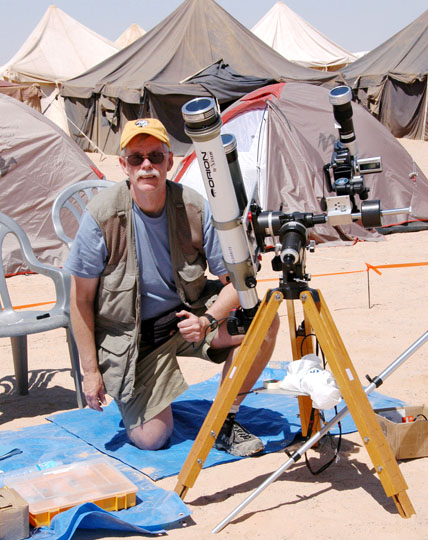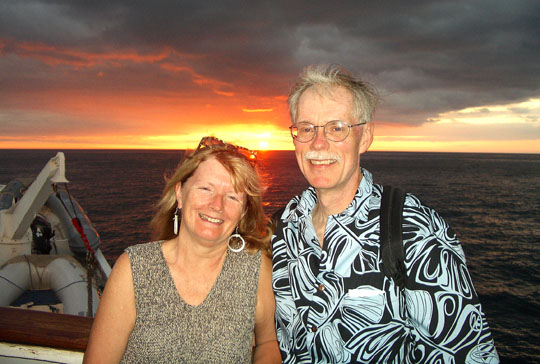Eclipse photos by UT alumnus featured on new stamp
By Vicki L. Kroll

featured on the new Forever stamp in Jalu, Libya, March 29, 2006.
“I was an amateur astronomer as a teenager, and I thought wow, it’s not that often a total eclipse crosses some part of the United States, so this may be my chance of a lifetime to see one,” he recalled.
At 16, he convinced his parents to let him borrow the family car and drove 600 miles from his home in Staten Island, N.Y., to Windsor, N.C.
“When the eclipse took place, I thought I was prepared because I had read magazine articles and books about it. I had my telescope set up to take some pictures,” Espenak said. “But when that shadow of the moon hit and we were plunged into this eerie twilight, it was so phenomenal and all-encompassing that when it was over, I thought: Oh, this can’t be once-in-a-lifetime; that went way too quickly; I’ve got to see another one.
“And the next one was in Canada two years later. That was the start of my very long career of chasing eclipses around the world.”
Planes, trains and automobiles have taken Espenak to 27 total eclipses on seven continents.
“The one in 1995 in India was unique. It was a short eclipse; it was only about 40 seconds long,” the UT alumnus said.
Yet it was momentous.
“It happened to be the eclipse trip that I met my wife on. She was on the trip to see her first total eclipse,” Espenak said. “It turns out, back in the States, Patricia lived about a six-hour drive from me, but we had to travel halfway around the world to run into each other.”
Together, the retired astrophysicist from NASA’s Goddard Space Flight Center and the retired chemistry teacher operate the Bifrost Astronomical Observatory in Portal, Ariz., and continue their quest to experience total eclipses.Next up: The Great American Total Eclipse Monday, Aug. 21. The sensational sky show that stars the moon passing between the sun and Earth will be visible in the contiguous United States for the first time since 1979 — weather permitting.
“The track of the moon’s shadow will cut diagonally across the nation from Oregon to South Carolina through 14 states. Inside the 70-mile-wide path of totality, the moon will completely cover the sun as the landscape is plunged into an unsettling twilight, and the sun’s glorious corona is revealed for more than two minutes,” Espenak explained.
He may be in Casper, Wyo., to watch the awe-inspiring event.
“There’s a big astronomy conference there called AstroCon 2017, and they invited me to speak four years ago. I think that’s the longest lead time I’ve had for a speaking invitation,” Espenak said. “Casper is right in the eclipse path.
 “But I don’t know where I’m going to be on eclipse day because it depends on what the forecast is one or two days before the eclipse. If the forecast is good for Casper, I’ll stay there. But if it’s not promising, I’m going to drive Sunday because I can get 600 or 800 miles east or west of Casper on the day before the eclipse.”
“But I don’t know where I’m going to be on eclipse day because it depends on what the forecast is one or two days before the eclipse. If the forecast is good for Casper, I’ll stay there. But if it’s not promising, I’m going to drive Sunday because I can get 600 or 800 miles east or west of Casper on the day before the eclipse.”
No passing fancy, but a passing obsession with astronomical objects led to Espenak’s nickname: Mr. Eclipse.
That memorable moniker and his international reputation as an eclipse expert helped land an ultra-cool gig with the U.S. Postal Service. While working on two books, “Eclipse Bulletin: Total Solar Eclipse 2017” and “Road Atlas for the Total Solar Eclipse 2017,” his phone rang.
“I got a call over a year ago that they were considering a commemorative stamp for the eclipse, and they wanted to know if I would act as a consultant on the technical information for the map on the back of the sheet and a description of the eclipse path,” Espenak said. “They also said they were looking for some photographs to possibly use as the stamp, and I said I would submit some images.”
Millions have seen his work; Espenak’s photos have been published in National Geographic, Nature and Newsweek. Check out mreclipse.com.

To commemorate the Aug. 21 event, the Total Eclipse of the Sun Forever stamp was released June 20 during a ceremony at the University of Wyoming in Laramie. Espenak and his wife were there.
“I’m honored to have my photographs on a stamp. But more importantly, the stamp will spread the news about America’s Great Eclipse to many more people,” he said. “And what a fantastic opportunity. For a lot of people, this is the chance of a lifetime to see a total eclipse.”
Meanwhile, he is giving talks around the country to preview the celestial spectacle. Espenak returned to his alma mater to speak June 15.
“Fred Espenak is another great example of a ‘rocket scientist’ who has really lived up to that name,” said Dr. Karen Bjorkman, dean of the College of Natural Sciences and Mathematics; Distinguished University Professor of Astronomy; and Helen Luedtke Brooks Endowed Professor of Astronomy. “He has made solid contributions to NASA science missions for many years, and is also doing a wonderful job of sharing his passion for and knowledge of eclipses with the public both on national and international stages. We’re really proud that he is an alumnus of The University of Toledo’s Department of Physics and Astronomy.”
During his talk funded by the Helen Luedtke Brooks Endowed Professorship in Astronomy, Espenak discussed eclipses and shared his eyewitness accounts around the globe through video and photos.And he offered two words of advice: road trip.
“I’m encouraging people to start making plans for a car trip to the eclipse path of totality because that’s where you have to be to see the total phase of the eclipse, and it’s worth the drive. It’s something you remember your entire life because it’s so unusual from anything you’ve seen before,” Espenak said. “The bright sun is completely gone in the sky, and you see this very strange-looking black disc, which is the unilluminated side of the moon, and it’s surrounded by this gossamer, feathery halo that’s the sun’s corona, which is two million degrees. It’s the only time you can see something that’s two million degrees with the naked eye. It’s such a stunning, overwhelming experience: The temperature drops probably 10 degrees as you go into totality, so you feel a chill in the air; animals react strangely; birds quiet down as if they’re going to roost at night.
“And it’s only for a few minutes. When it’s over, you really have a desire to see it again.”








